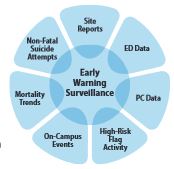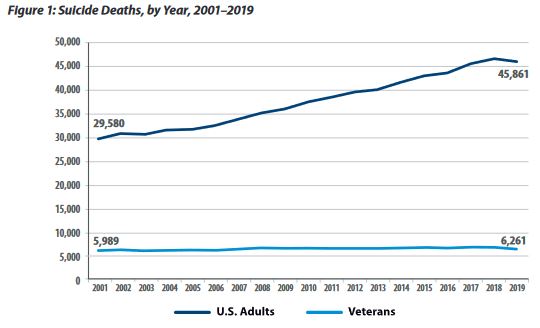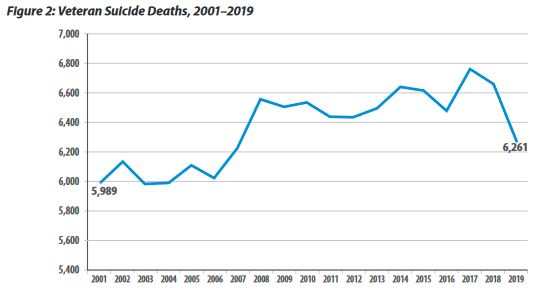VA Worries That Out-of-Date Numbers Could Mislead
WASHINGTON — According to VA’s 2021 National Veteran Suicide Prevention Annual Report, veteran suicides dropped in 2019, reversing the steady rise seen in previous years. According to the report, there were 6,261 veteran who took their own lives that year, 399 fewer than in 2018. The last time the total number had been that low was 2007.
Veterans remain at a considerably higher risk than their civilian counterparts, however, and veteran advocates worry that this data—already nearly two years old—may be woefully out of date. Specifically, they are concerned about the effects not just of COVID-19, but the economic aftershocks of the pandemic, as well as the recent withdrawal of U.S. troops from Afghanistan.
At a House VA Committee hearing last month, department officials touted the numbers as evidence of “unprecedented levels of progress.”
“What we’ve learned so far from the data is that 2019 represented the full start of … our public health approach—the implementation of a clinically based plan combined with a community based plan,” explained Matthew Miller, PhD, MPH, executive director of VA’s Suicide Prevention Program.
This public health approach—known as Suicide Prevention 2.0—combines VISN, state and local-level prevention initiatives with clinical interventions for veterans who are at increased risk for suicide.
However, Rajeev Ramchand, a senior behavioral scientist at the RAND Corp., testified that effective veteran suicide prevention would require more accurate and up-to-date data than what VA was currently collecting.
“The VA just released data on veterans suicides from 2019, meaning that our data is over 20 months delayed,” Ramchand declared. “Whether the impacts of COVID-19 or the withdrawal of troops from Afghanistan have led to increased veteran suicide is currently unanswerable due to the lack of timely data.”
VA gets its mortality data from the national Centers for Disease Control and Prevention, which receives it from over 2,000 jurisdictions across the country with the authority to conduct death investigations. In order to speed up that process, the United States would have to make sure those local jurisdictions had the funding to update antiquated systems and for investigators to swiftly and accurately conduct their investigations.
The quality of the mortality data reaching the CDC also would need to be improved, Ramchand added, especially when it comes to gender, sexual orientation, and race and ethnicity.
“This is especially important for American Indian and Alaskan Native individuals, who have the highest rate of suicide in the United States but whose race is often incorrectly identified on death certificates,” Ramchand told the committee.
VA also was in need of better data when it comes to veterans receiving healthcare outside the VA, Ramchand said. When a suicide occurs, researchers need to know where that veteran last received care and what type of care it was, so that VA can better understand how to prevent future suicides.
The impact of the Afghanistan withdrawal on suicides and overall veteran mental health is another topic of interest that’s been obscured by a general lack of data.
“Many veterans watched as their former bases were taken over by the enemy that they selflessly fought alongside Afghan and NATO forces to defeat for two decades. Feelings of anger, sadness and despair filled the hearts of our nation’s veterans, servicemembers and families. And, for some, the trigger of these events brought unexplainable pain and changed the way they viewed the war,” declared Kaitlynne Hetrick, government affairs associate for the Iraq and Afghanistan Veterans of America (IAVA).
Afghanistan Withdrawal
According to Hetrick, IAVA’s Quick Reaction Force—a concierge program helping veterans and family members navigate veteran-centered services, saw an 80% increase in mental healthcare inquiries from Aug. 16-31, 2021, compared with those dates in 2020.
The VA advised that only about 2% of calls coming into VA’s Veteran Crisis Line (VCL) during that same timeframe were directly attributable to the events in Afghanistan, with another 5-6% having Afghanistan noted in the call documentation.
One area where there was positive consensus was in the success of VA’s peer specialist (PS) program. Peer specialists are VA employees who also happen to be veterans in recovery from mental illnesses and substance abuse disorders who can help fellow veterans navigate VA services. Legislators, VSOs and VA officials all agreed that veterans responded positively to working with someone who could relate to their experience.
This year, the VCL began using peer specialists to conduct follow-up calls to veterans who had called the crisis line.
“That was developed with the mission to provide support, hope, and recovery-oriented services to veterans who were identified as high risk,” Miller explained.
Committee Chairman Rep. Mark Takano (D-CA) identified the PS initiative as an easy place for legislators on both sides of the aisle to begin increasing resources. “I think this is an area where we could build consensus around and ramp up our [PS] workforce more quickly and also have it be more diverse, so we have more relatable folks within our mental health workforce,” he said.
One program that Republicans on the committee were leery about was VA’s lethal means safety initiative, which provides veterans with information on gun safety, as well as securing their firearms.
“There is no one single explanation for suicide, and there is no one solution,” Miller noted. “[But] 70% of the time [for veteran suicide] it comes down to one lethal means, and that’s firearms.”
Research has shown that by increasing the time between when a person has a suicidal intention and their ability to put their hands on a gun can drastically improve survival rates. Therefore, VA’s safety recommendations include guidance on handing firearms over to a friend, utilizing storage units or storage options at firearm clubs, or pawning or selling firearms entirely.
At Republican legislators’ urging, Miller stressed that VA’s firearms safety recommendations are entirely optional, and that VA is not pursuing any mandatory relinquishing of firearms.
According to Takano, firearm safety and peer specialist funding will be part of an upcoming legislative package focusing on mental health and suicide prevention. It’s expected to direct VA on how to train its community mental health providers; strengthen the VCL; increase the number of vet centers across the country; and auto-enroll servicemembers separating from active duty into VA databases during the transition process.
“Everything we do upstream to give veterans and their families stability, meaning, purpose and joy in their lives is suicide prevention,” Takano declared. “Stable housing is suicide prevention; financial security is suicide prevention; food is suicide prevention. Access to high quality affordable healthcare, including mental healthcare, is suicide prevention. Education and employment with a living wage is suicide prevention. Addressing the effects of trauma, including sexual assault, is suicide prevention. Addressing social isolation and loneliness is suicide prevention. Encouraging lethal means safety, especially getting everyone to store their firearms and ammunition safely, is suicide prevention. And treating all veterans with respect, inclusive of their gender, race, ethnicity and sexual orientation is suicide prevention.”



